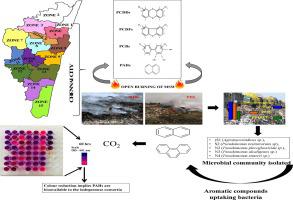Waste Management ( IF 7.1 ) Pub Date : 2021-07-02 , DOI: 10.1016/j.wasman.2021.06.015 Sancho Rajan 1 , K Ronnie Rex 1 , Mukesh Pasupuleti 2 , Juan Muñoz-Arnanz 3 , Begoña Jiménez 3 , Paromita Chakraborty 1

|
Several studies have reported the release of halogenated persistent organic pollutants (POPs) and polycyclic aromatic hydrocarbons (PAHs) associated with open burning of municipal solid waste. Considering soil as a sink for such organic contaminants, we conducted an in-depth study on the surface soil concentrations of polychlorinated dibenzo-p-dioxins/furans (PCDD/Fs), polychlorinated biphenyls (PCBs) and sixteen USEPA enlisted PAHs collected from thirteen zones of the two major municipal dumpsites, Kodungaiyur dumpsite (KDS) and Perungudi dumpsite (PDS) of Chennai city. Indigenous microbes from dumpsite soil samples were isolated and identified based on 16S rRNA sequencing and phylogenetic analysis. Using indigenous microbes, we have elucidated the bioavailability of the targeted organic pollutants for each site. Range of Σ17PCDD/Fs, Σ25PCBs and ∑16PAHs varied between 3.96–612 pg/g (96.0 pg/g; median), ND-182 ng/g (6.35 ng/g; median) and 0.62–3649 ng/g (64.3 ng/g; median), respectively. All the dumpsite samples showed bioavailability for POPs and PAHs. Toxicity equivalent values (TEQs) associated with dioxin-like PCBs and PCDD/Fs from the zones where dumped municipal solid wastes were collected from electronic-waste/IT-corridor/port areas and toxic PAHs from the zone receiving wastes from the industrial corridor of the city were higher than the soil permissible limit prescribed by the World Health Organization.
中文翻译:

印度钦奈市露天垃圾场中多氯二苯并二恶英/呋喃、多氯联苯和多环芳烃的土壤浓度、成分分布、来源和生物利用度
一些研究报告了与城市固体废物露天燃烧相关的卤化持久性有机污染物 (POP) 和多环芳烃 (PAH) 的释放。考虑到土壤是此类有机污染物的汇,我们对土壤表层多氯二苯对磷的浓度进行了深入研究。- 二恶英/呋喃 (PCDD/Fs)、多氯联苯 (PCBs) 和 16 种美国环保署纳入的 PAHs 从两个主要市政垃圾场的 13 个区域收集,即金奈市 Kodungaiyur 垃圾场 (KDS) 和 Perungudi 垃圾场 (PDS)。基于 16S rRNA 测序和系统发育分析,从垃圾场土壤样品中分离和鉴定了本土微生物。我们使用本土微生物阐明了每个地点的目标有机污染物的生物利用度。 Σ 17 PCDD/Fs、Σ 25 PCB 和 Σ 16 的范围PAH 分别在 3.96–612 pg/g(96.0 pg/g;中位数)、ND-182 ng/g(6.35 ng/g;中位数)和 0.62–3649 ng/g(64.3 ng/g;中位数)之间变化。所有垃圾场样本都显示出持久性有机污染物和多环芳烃的生物利用度。与从电子废物/IT 走廊/港口区收集倾倒城市固体废物的区域中的二恶英类多氯联苯和 PCDD/F 相关的毒性当量值 (TEQ) 以及从工业走廊接收废物的区域中的有毒多环芳烃该城市高于世界卫生组织规定的土壤允许限值。











































 京公网安备 11010802027423号
京公网安备 11010802027423号